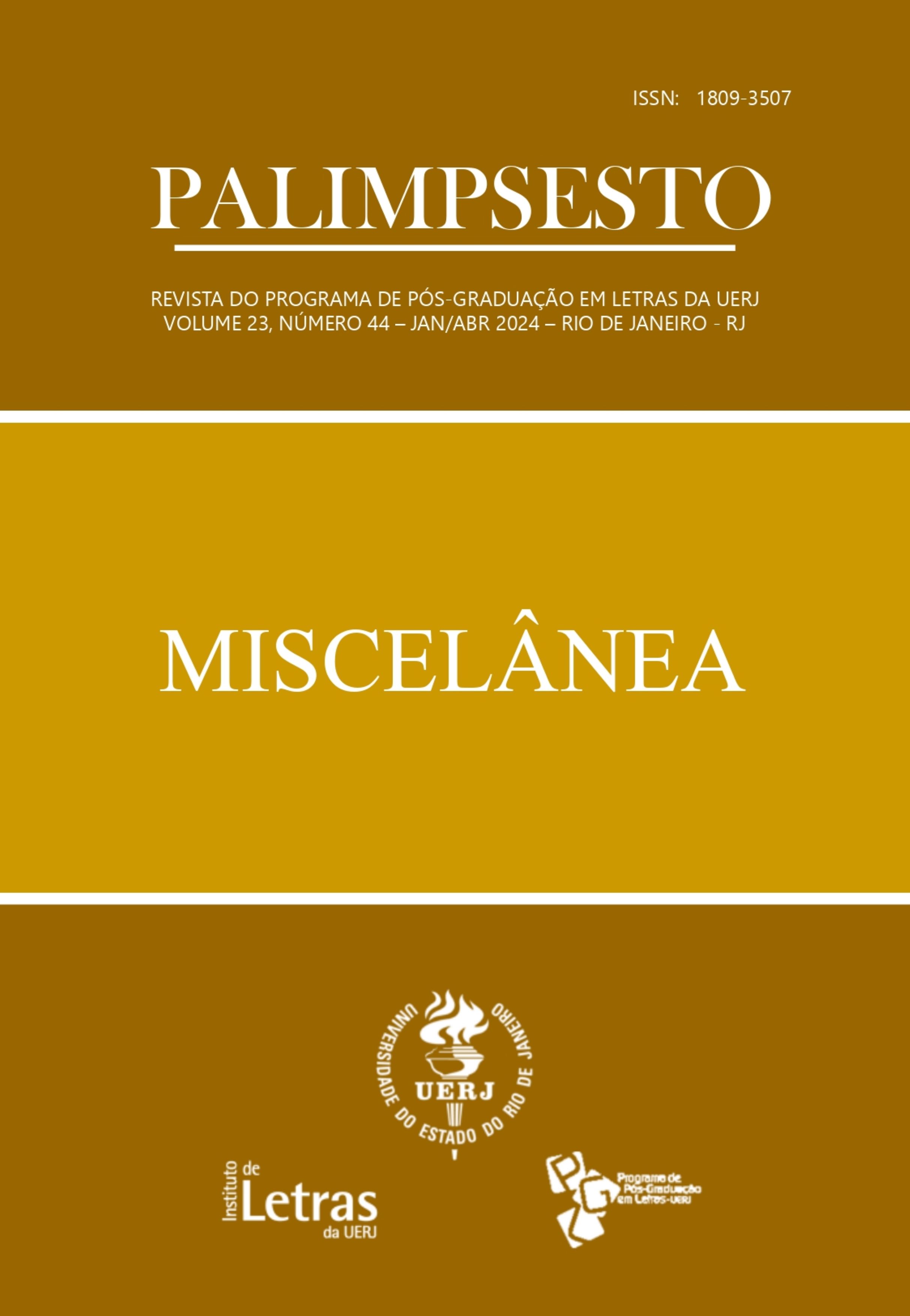Ofélia recriada em “Melancolia” de Lars Von Trier
DOI:
https://doi.org/10.12957/palimpsesto.2024.76241Keywords:
Melancolia, Lars von Trier, Ofélia, pós-modernidade, literatura e audiovisual.Abstract
O filme Melancolia (2011), de Lars von Trier, é iniciado por 16 cenas de uma paródia cinematográfica concebida a partir de célebres pinturas, sendo a principal “Ophelia” (1852), de Millais. A partir disso, deseja-se investigar quão profundamente está enraizada Ofélia, personagem da peça Hamlet (1603), de Shakespeare, no desenvolvimento do filme; e, até que ponto, esse empréstimo alicerça sua forma. Portanto, noções de confisco e citação serão debatidas enquanto se percebe que conceitos, como originalidade e autenticidade, são enfraquecidos. Trier parece criar em linguagem cinematográfica o abandono contemporâneo por meio da personagem shakespeariana. Para tanto, a investigação estará alicerçada nos pressupostos de Linda Hutcheon (1989), de Antonio Candido (1976) e de Ismail Xavier (1984).
Downloads
References
ARAÚJO, Marta de Pinheiro. “Dos corpos, das vestes, do movimento e da catástrofe: Melancolia, de Lars Von Trier”. In: TRINDADE, Denise (org.) Imaginários de cinema e moda. RJ: Synergia, 2013, p. 23 – 30.
BAINBRIDGE, Caroline. The Cinema of Lars von Trier: Authenticity and Artifice. London & New York: Wallflower Press, 2007, p. 210.
BARROS, José D’Assunção. O romantismo e o revival gótico no século XIX. Artefilosofia, v. 4, n. 6, 2009, p. 169-182.
BOULTER, Jonathan. “Melancholy and the Archive: Trauma, Memory, and History”. In: The Contemporary Novel. London & New York: Continuum, 2011.
CANDIDO, Antonio et al. A personagem de ficção. São Paulo: Perspectiva, 1976.
CHAVES MONTEIRO, Ênio; LUCIA PIRES, Vera. “Melancolia de von Trier: Ophélia Contemporânea. Nonada”. In: Letras em Revista. 2015; 1(24):224-242. Disponível em: <https://www.redalyc.org/articulo.oa?id=512451510017>. Acesso em: 09 jan. 2024.
CORRÊA, Graça. “Gothic-Romantic Ecocentric Landscapes”. In: Lars von Trier’s Melancholia. Avanca: Cinema International Conference, Avanca: Edições Cine-Clube, 2012, 180-7.
DAMIÃO, Carla Milani. A morte como libertação ou a estetização da morte. Ilhéus: Especiaria, v. 11, n. 19, 2008, p. 320-332.
DELEUZE, G. Lógica do sentido. São Paulo: Perspectiva. 1982.
FREUD, Sigmund. Luto e melancolia. São Paulo: Editora Cosac Naify, 2014.
GOMES, Paulo Emilio Sales. “A personagem cinematográfica”. In: CANDIDO, Antonio (Org.). A personagem de ficção. São Paulo: Perspectiva, 1976.
HALL, S. A identidade cultural na pós-modernidade. Trad. Tomaz Tadeu da Silva e Guacira Lopes Louro. 7. Ed. Rio de Janeiro: DP&A, 2003.
HOESTEREY, Ingeborg. Pastiche: Cultural memory in art, film, literature. Indiana University Press, 2001.
HUTCHEON, Linda; PÉREZ, Teresa Louro. Uma teoria da paródia: ensinamentos das formas de arte do século XX. Lisboa: Edições 70. 1989.
KRISTEVA, Julia. Black Sun: Depression and Melancholia. Translated by Leon. New York: Columbia University Press, 1989.
OLIVEIRA, Fábio Crispim. “A intermidialidade subversiva na narrativa cinematográfica de Lars Von Trier”. In: XI Congresso Internacional da ABRALIC – Tessituras, Interações, Convergências. São Paulo: 2008.
PETERSON, Kaara L.; WILLIAMS, Deanne. “Introduction: The Afterlives of Ophelia”. In: The afterlife of Ophelia. New York: Palgrave Macmillan, 2012. p. 1-9.
POE, Edgar Allan. The Raven and The Philosophy of Composition. Paul Elder and Company. San Francisco and New York. 2017.
PRADO, Decio de Almeida. “A personagem no teatro”. In: CANDIDO, Antonio (Org). A personagem de ficção. São Paulo: Perspectiva, 1976.
ROMESTANT, Lilly E. “Ophelia and the Feminine Construct”. In: Oglethorpe Journal of Undergraduate Research. v. 5, 2015. Disponível em: <https://digitalcommons.kennesaw.edu/ojur/vol5/iss3/1>. Acesso em: 09 jan. 2024.
RUFINONI, Simone Rossinetti. “Paradoxos da Melancolia. Uma Leitura do Filme Melancolia, de Lars von Trier”. In: Revista de Linguagem do Cinema e do Audiovisual, v. 5, n. 1, 2016, p. 69-77.
SCHWANDER, Lars. We Need More Intoxicants in Danish Cinema. Levende Billeder, p. 13-23, 1983.
SHAKESPEARE, William. Hamlet. Penguin, 1998.
SMITH, Barbara. Neither Accident nor Intent: Contextualizing the Suicide of Ophelia. South Atlantic Review 73. JSTOR: 2008, p. 96-112.
STĘPNIK, Małgorzata. “The House that Lars Built. The Architecture of Transgression”. In: Arts: Multidisciplinary Digital Publishing Institute, 2020. p. 127.
TARKOVSKI. Andrei Arsenyevich. Esculpir o tempo/Tarkovski. Tradução Jefferson Luiz Camargo. 2. Ed. São Paulo: Martins Fontes, 1998.
THORSEN, Nils; TRIER, Lars von. “Longing for the End of All”. In: Interview with Lars von Trier, 2011.
XAVIER, Ismail. O discurso cinematográfico: a opacidade e a transparência. 3. Ed. São Paulo, Paz e Terra, 2005.
Downloads
Published
How to Cite
Issue
Section
License
Palimpsesto journal publishes original articles and reviews in the field of Literature, Language and Linguistics. We also publish mixed and/or thematic issues, with articles and reviews in Portuguese, English, Spanish, and French.
Authors retain copyright and grant the journal the right of its first publication, with the work simultaneously licensed under Creative Commons Attributions License, which allows sharing of the work with an acknowledgement of authorship and initial publication in this journal.

Palimpsesto uses a Creative Commons - Atribuição-NãoComercial 4.0 Internacional license.







